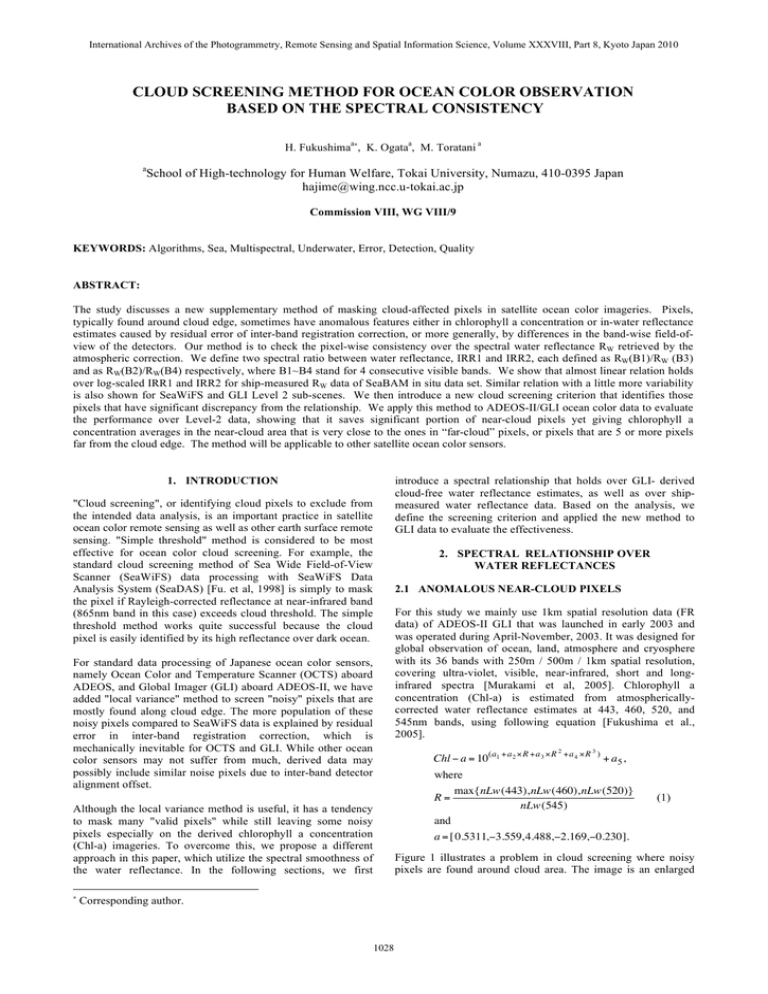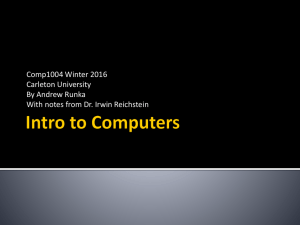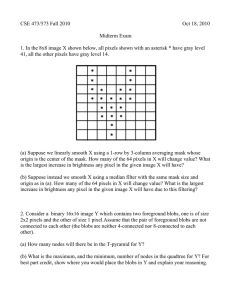CLOUD SCREENING METHOD FOR OCEAN COLOR OBSERVATION
advertisement

International Archives of the Photogrammetry, Remote Sensing and Spatial Information Science, Volume XXXVIII, Part 8, Kyoto Japan 2010
CLOUD SCREENING METHOD FOR OCEAN COLOR OBSERVATION
BASED ON THE SPECTRAL CONSISTENCY
H. Fukushimaa∗, K. Ogataa, M. Toratani a
a
School of High-technology for Human Welfare, Tokai University, Numazu, 410-0395 Japan
hajime@wing.ncc.u-tokai.ac.jp
Commission VIII, WG VIII/9
KEYWORDS: Algorithms, Sea, Multispectral, Underwater, Error, Detection, Quality
ABSTRACT:
The study discusses a new supplementary method of masking cloud-affected pixels in satellite ocean color imageries. Pixels,
typically found around cloud edge, sometimes have anomalous features either in chlorophyll a concentration or in-water reflectance
estimates caused by residual error of inter-band registration correction, or more generally, by differences in the band-wise field-ofview of the detectors. Our method is to check the pixel-wise consistency over the spectral water reflectance RW retrieved by the
atmospheric correction. We define two spectral ratio between water reflectance, IRR1 and IRR2, each defined as RW(B1)/RW (B3)
and as RW(B2)/RW(B4) respectively, where B1~B4 stand for 4 consecutive visible bands. We show that almost linear relation holds
over log-scaled IRR1 and IRR2 for ship-measured RW data of SeaBAM in situ data set. Similar relation with a little more variability
is also shown for SeaWiFS and GLI Level 2 sub-scenes. We then introduce a new cloud screening criterion that identifies those
pixels that have significant discrepancy from the relationship. We apply this method to ADEOS-II/GLI ocean color data to evaluate
the performance over Level-2 data, showing that it saves significant portion of near-cloud pixels yet giving chlorophyll a
concentration averages in the near-cloud area that is very close to the ones in “far-cloud” pixels, or pixels that are 5 or more pixels
far from the cloud edge. The method will be applicable to other satellite ocean color sensors.
1. INTRODUCTION
introduce a spectral relationship that holds over GLI- derived
cloud-free water reflectance estimates, as well as over shipmeasured water reflectance data. Based on the analysis, we
define the screening criterion and applied the new method to
GLI data to evaluate the effectiveness.
"Cloud screening", or identifying cloud pixels to exclude from
the intended data analysis, is an important practice in satellite
ocean color remote sensing as well as other earth surface remote
sensing. "Simple threshold" method is considered to be most
effective for ocean color cloud screening. For example, the
standard cloud screening method of Sea Wide Field-of-View
Scanner (SeaWiFS) data processing with SeaWiFS Data
Analysis System (SeaDAS) [Fu. et al, 1998] is simply to mask
the pixel if Rayleigh-corrected reflectance at near-infrared band
(865nm band in this case) exceeds cloud threshold. The simple
threshold method works quite successful because the cloud
pixel is easily identified by its high reflectance over dark ocean.
2. SPECTRAL RELATIONSHIP OVER
WATER REFLECTANCES
2.1 ANOMALOUS NEAR-CLOUD PIXELS
For this study we mainly use 1km spatial resolution data (FR
data) of ADEOS-II GLI that was launched in early 2003 and
was operated during April-November, 2003. It was designed for
global observation of ocean, land, atmosphere and cryosphere
with its 36 bands with 250m / 500m / 1km spatial resolution,
covering ultra-violet, visible, near-infrared, short and longinfrared spectra [Murakami et al, 2005]. Chlorophyll a
concentration (Chl-a) is estimated from atmosphericallycorrected water reflectance estimates at 443, 460, 520, and
545nm bands, using following equation [Fukushima et al.,
2005].
For standard data processing of Japanese ocean color sensors,
namely Ocean Color and Temperature Scanner (OCTS) aboard
ADEOS, and Global Imager (GLI) aboard ADEOS-II, we have
added "local variance" method to screen "noisy" pixels that are
mostly found along cloud edge. The more population of these
noisy pixels compared to SeaWiFS data is explained by residual
error in inter-band registration correction, which is
mechanically inevitable for OCTS and GLI. While other ocean
color sensors may not suffer from much, derived data may
possibly include similar noise pixels due to inter-band detector
alignment offset.
Chl − a = 10(a1 +a 2 ×R +a 3 ×R
+a 4 ×R 3 )
+ a5 ,
where
max{nLw(443),nLw(460),nLw(520)}
R=
nLw(545)
and
a = [ 0.5311,−3.559,4.488,−2.169,−0.230].
Although the local variance method is useful, it has a tendency
to mask many "valid pixels" while still leaving some noisy
pixels especially on the derived chlorophyll a concentration
(Chl-a) imageries. To overcome this, we propose a different
approach in this paper, which utilize the spectral smoothness of
the water reflectance. In the following sections, we first
(1)
Figure 1 illustrates a problem in cloud screening where noisy
pixels are found around cloud area. The image is an enlarged
€
∗
2
Corresponding author.
1028
International Archives of the Photogrammetry, Remote Sensing and Spatial Information Science, Volume XXXVIII, Part 8, Kyoto Japan 2010
thousand in situ data, where the distribution density is colorcoded and normalized by the maximum density. Although it is
true that the SeaBAM data set consists of mostly samples from
Case 1 waters, all the data points are very closely distributed to
the linear fit.
portion of Chl-a image derived from a South Pacific GLI data
taken on May 3, 2003. Here, cloud pixels (in black) are
identified by the standard GLI cloud masking method which
consists of pixel-wise "simple threshold" and 3*3 "local
variance" technique over aerosol reflectance at 865nm band.
Cloud-adjacent pixels, or the pixels adjacent to the "cloud
pixels", are also masked.
(a)
Figure 1. Cloud-screened Chl-a [µg/l] imagery of GLI
data, a South Pacific scene of May 3, 2003. Noisy pixels
are seen around the edge of the cloud (black pixels).
These noisy pixels are caused by "unsmooth" satellite-derived
water reflectance spectrum. As one can expect, water
reflectance varies systematically with the change in water
constituent. It should have "smooth" spectral shape as illustrated
in Figure 2 (a), where the data are sampled at pixels more than
five pixels away from the cloud edge. On the contrary, "nearcloud" pixels tend to show "zig-zag" features in water
reflectance spectra (b). The new method we are to propose in
this study is based on the idea to detect this un-smoothness,
utilizing an inter-band relationship of the spectral water
reflectances at four visible bands which are typically used to
estimate chlorophyll a concentration.
(b)
(c)
Wavelenth (nm)
Wavelenth (nm)
(a) Cloud free pixels
(b) Near-cloud pixels
Figure 2. Example of GLI-derived normalized waterleaving radiance spectra (in µW/cm2/nm/sr) taken from a
Pacific scene on June 6, 2003.
2.2 Spectral relationship over water reflectances
(d)
Figure 3 (a), which is composed from SeaBAM (SeaWiFS Biooptical Algorithm Mini-workshop) data set [O’Reiley et al,
1998], shows a relation between two different spectral ratios of
water reflectances, Rrs(490)/Rrs(555) and Rrs(443)/Rrs(510),
where Rrs(λ) is defined by
Lw(λ )
.
(2)
Rrs(λ ) =
Ed(λ )
Here, λ is wavelength, LW is water-leaving reflectance and Ed is
downward solar irradiance just above the ocean surface. Figure
3 (a) depicts a two-dimensional histogram of about one
€
Figure 3. Inter-band relation of remote sensing reflectance.
(a) SeaBAM in situ data set. (b) SeaWiFS data of April 17,
2003. (c) Inter-band relation of the SeaWiFS data. (d) The
same but for GLI South Pacific scene of June 6, 2003.
1029
International Archives of the Photogrammetry, Remote Sensing and Spatial Information Science, Volume XXXVIII, Part 8, Kyoto Japan 2010
3. EVALUATION OF THE PROPOSED METHOD
3.1 Definition of the method
We define here a “reference relationship” of between two interband reflectance ratios IRR1 = Rrs(443)/Rrs(520) and IRR2 =
Rrs(460)/Rrs(545) as
log10 IRR 2 = 0.865 log10 IRR1 + 0.184 ,
(3)
which was determined from the analysis of an 8 day global
Level 2 data of GLI. Then, the new scheme, which we call
€
“Inter-band Reflectance Consistency (IRC)” test, is described as
follows.
3.2 IRC criteria
1) The pixel should meet the following condition,
Ref – 0.2 < log10IRR2 < Ref + 0.2,
where Ref is the value of right-hand side of (3) based on the
satellite-derived IRR1.
2) The pixel also should meet
0.1 < log10IRR1 < 20, and 0.1 < log10IRR2 < 20.
The scheme for pixel-wise screening is to “mask” the pixel if
it does not meet 1) and 2) at the same time.
3.3 Evaluation by comparison with local variance test
Figure 4. Inter-band relation of remote sensing
reflectance on GLI South Pacific scene of June 6, 2003.
(a) Cloud-adjacent pixels with Chl-a > 10.0 or with Chl-a
< 0.01 µg/l. (b) Far-cloud pixels with 0.05 < Chl-a < 10
µg/l.
Similar distributions are obtained in the satellite-estimated
water-reflectance spectra. Figure 3 (b) shows RGB imagery of
a SeaWiFS scene of April 17, 2003 and the IRR1 and IRR2
distribution is depicted in panel (c). Figure 3 (d) is a similar plot
but for the samples taken from a South Pacific scene of GLI,
obtained on June 6, 2003. Note that the band selection is
slightly changed because of the different band allocation of GLI.
The figure shows high correlation similar to the SeaBAM and
the SeaWiFS cases but with more scatterance, which should
correspond to the pixels with the anomalous water reflectance
spectrum.
To further investigate, we repeated the same analysis with
limited samples of near-cloud pixels. Figure 4 (a) shows the
plots for the same GLI data but for those pixels that are adjacent
to any cloud pixel and have Chl-a value of "out of range (Chl-a
< 0.01 or Chl-a > 10.0 µg/l). In contrast, Figure 4 (b) is also the
result of the same scene but with the pixels that are enough far
(more than 5 pixels) from any cloud pixel and have "likely
range of Chl-a (0.05 < Chl-a < 10.0 mg/l)". By comparison of
these results, we can define a new scheme for screening those
pixels with anomalous spectra to remove all the pixels that fall
within the surrounding scattered area of the diagram.
As one can expect, proposed IRC test masks less number of
pixels around cloud compared to the local variance test. Figure
5 illustrates this nature, showing the results of different cloud
screening methods applied to a South China Sea scene of April
3, 2003, where the three panels are Chl-a images with (a) simple
threshold, with (b) simple threshold an additional local variance,
with (c) simple threshold and additional IRC tests, respectively.
As seen in the figure, the case (c) (simple threshold + IRC)
(a) Simple threshold
(b) threshold + local variance
(c) Simple threshold + IRC.
Figure 5. Performance of different cloud mask applied
to South China sea Chl-a image of April 3, 2003.
1030
International Archives of the Photogrammetry, Remote Sensing and Spatial Information Science, Volume XXXVIII, Part 8, Kyoto Japan 2010
(a) Number of available pixels
(a) Chl-a average
(b) Standard deviaton of log[Chl-a]
(b) Standard dev. of log[Chl-a]
Figure 6. Cloud mask performance comparison between local
variance and IRC methods.
obviously masks much less number of pixels compared to (b),
yet masking significant portion of anomalous pixels seen on the
cloud edge (in Figure 5 (a)).
Figure 7. Cloud mask performance comparison
between GLI standard method and modified IRCadded method.
4. CONCLUSION
As a quantitative evaluation, we compared number of available
(not cloud-masked) pixels for the local variance test and for the
IRC test over “cloud edge” and “far-cloud” pixels for the South
Pacific GLI image used in Figure 4 (Figure 6 (a)). From the
results, IRC test produces about 50% more valid pixels in
“Near-cloud” area compared to the local variance test, where a
“Near-cloud” pixel is the one adjacent to any cloud pixel. Note
that, as shown in Figure 6(b), the standard deviation in the nearcloud area under the two methods is just the same. This can be
interpreted that the quality of the IRC cloud screening is just the
same as the local variance method, although the difference in
standard deviation between cloud edge pixels and far-cloud
pixels may mean the necessity of further improvement of cloud
screening tests.
We proposed a new cloud screening method that utilizes “interband consistency” of the water reflectance. It leaves more
“near-cloud” pixels compared to “local variance” method while
detecting dubious pixels just as the local variance method does.
Although we have developed this method over GLI data, the
technique is also applicable to other satellite ocean color data.
It might be pointed out that the method is based on the spectral
nature of the “Case-I” waters where optical properties of the
water is controlled only by phytoplankton, and hence the
method may not work against some extraordinary environments
such as red-tide, high-turbidity or coccolithophore blooms.
While we propose this method as an additional cloud-screening
algorithm as a part of the JAXA standard SGLI ocean color data
processing, further studies should be conducted to enhance the
applicability of the method over various water types and
atmospheric conditions.
3.4 Evaluation as an additional cloud screening test
We evaluated the performance of the proposed scheme as an
additional cloud test to the standard GLI cloud screening, which
consists of simple threshold/local variance tests and cloudadjacent pixel masking. Figure 7 shows statistical results
obtained under the GLI standard method (“wo. IRC”) and under
the standard method with IRC test (“w. IRC”) for the South
Pacific GLI scene of June 5, 2003. As seen in Figure 7(a), it is
noteworthy that the modified method with IRC test gives just
the same Chl-a average for cloud-edge and for far-cloud pixels.
At the same time, the factor of 2 difference in standard
deviation of Chl-a between cloud-edge and far-cloud pixels
(Figure 7(b)) may necessitate further study.
References
Fu, G., Baith, K. S., and McClain, C. R., SeaDAS: The
SeaWiFS Data Analysis System, Proceedings of the 4th Pacific
Ocean Remote Sensing Conference, Qingdao, China, July 28-31,
1998, 73-79. 1998.
Fukushima, H., M. Toratani, H. Murakami, P. Deschamps, R.
Frouin, and A. Tanaka, Validation of ADEOII/GLI ocean color
1031
International Archives of the Photogrammetry, Remote Sensing and Spatial Information Science, Volume XXXVIII, Part 8, Kyoto Japan 2010
atmospheric correction based on ship-board hand-held
spectroradiometer measurements, Proc. of SPIE, 5885, 5885051 – 588505-8, 2005.
Murakami, H., M. Yoshida, K. Tanaka, H. Fukushima, M.
Toratani, A. Tanaka, and Y. Senga, Vicarious calibration of
ADEOS/GLI visible to shortwave infrared bands using global
datasets, Trans. Geosci. Rem. Sens., 43, 7, 1571-1584, 2005.
O’Reiley, J. E., S. Maritorena, B.G. Mitchell, D. A. Siegel, K. L.
Carder, S. A. Garver, M. Kahru, C. McClain, Ocean color
chlorophyll algorithms for SeaWiFS, J. Geophys. Res.,102,
24937-24953, 1998.
Acknowledgements
This work was supported by Japan Aerospace
Exploration Agency (JAXA) under contract JX-PSPC307627.
1032





